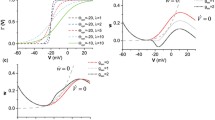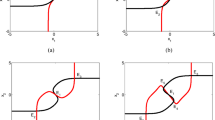Abstract
When a certain input--output mapping is memorized, the neural dynamics provide a prescribed neural activity output that depends on the external input. Without such an input, neural states do not provide memorized output. Only upon input, memory is recalled as an attractor, while neural activity without an input need not fall on such attractor but can fall on another attractor distinct from the evoked one. With this background, we propose that memory recall occurs as a bifurcation from the spontaneous attractor to the corresponding attractor matching the requested target output, as the strength of the external input is increased. We introduce a neural network model that enables the learning of such memories as bifurcations. After the learning process is complete, the neural dynamics are shaped to generate a prescribed target in the presence of each input. We find that the capacity of such memory depends on the timescales for the neural activity and synaptic plasticity. The maximal memory capacity is achieved at a certain relationship between the timescales, where the residence time at previous learned targets during the learning process is minimized.








Similar content being viewed by others
References
Willshaw DJ, von derMalsburg C (1976) How patterned neural connections can be set up by self-organization. Royal Soc Lond Proc Ser B 194:431
Hopfield JJ (1984) Neurons with graded response have collective computational properties like those of two-state neurons. Proc Natl Acad Sci USA 81(10):3088
Kohonen T (1982) Self-organized formation of topologically correct feature maps. Biol Cybern 43(1):59
Barto AG, Sutton RS, Brouwer PS (1981) Associative search network: a reinforcement learning associative memory. Biol Cybern 40(3):201
Rumelhart DE, Mcclelland JL (1986) Parallel distributed processing: explorations in the microstructure of cognition, vol 1. Foundations. MIT Press, Cambridge
Luczak A, Bartho P, Marguet SL, Buzsaki G, Harris KD (2007) Sequential structure of neocortical spontaneous activity in vivo. Proc Nat Acad Sci 104(1):347
Luczak A, Bartho P, Harris KD (2009) Spontaneous events outline the realm of possible sensory responses in neocortical populations. Neuron 62(3):413
Fox MD, Corbetta M, Snyder AZ, Vincent JL, Raichle ME (2006) Spontaneous neuronal activity distinguishes human dorsal and ventral attention systems. Proc Nat Acad Sci 103(26):10046
Arieli A, Sterkin A, Grinvald A, Aertsen A (1996) Dynamics of ongoing activity: explanation of the large variability in evoked cortical responses. Science 273(5283):1868
Mazor O, Laurent G (2005) Transient dynamics versus fixed points in odor representations by Locust Antennal Lobe projection neurons. Neuron 48(4):661
Kurikawa T, Kaneko K (2011) Learning shapes spontaneous activity itinerating over memorized states. PLoS ONE 6(3): e17432. doi:10.1371/journal.pone.0017432
Xie X, Seung HS (2004) Learning in neural networks by reinforcement of irregular spiking. Phys Rev E 69(4):41909
Jay TM (2003) Dopamine: a potential substrate for synaptic plasticity and memory mechanisms. Prog Neurobiol 69(6):375
Reynolds JNJ, Hyland BI, Wickens JR (2001) A cellular mechanism of reward-related learning. Nature 413(6851):67
Fusi S, Drew PJ, Abbott LF (2005) Cascade models of synaptically stored memories. Neuron 45(4):599
Acknowledgments
This work is partially supported by the people of Japan, via a Grant-in-Aid for scientific research (No.21120004) from MEXT, Japan.
Author information
Authors and Affiliations
Corresponding author
Rights and permissions
About this article
Cite this article
Kurikawa, T., Kaneko, K. Learning to memorize input--output mapping as bifurcation in neural dynamics: relevance of multiple timescales for synapse changes. Neural Comput & Applic 21, 725–734 (2012). https://doi.org/10.1007/s00521-011-0650-2
Received:
Accepted:
Published:
Issue Date:
DOI: https://doi.org/10.1007/s00521-011-0650-2




